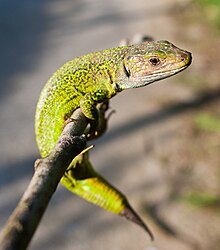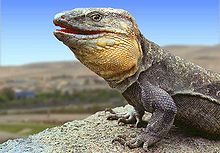Jaszczurkowate
| Lacertidae[1] | |||
| Bonaparte, 1838 | |||
(c) I,Stanislaw Szydlo, CC BY-SA 3.0 Przedstawiciel rodziny – jaszczurka zwinka (Lacerta agilis) | |||
| Systematyka | |||
| Domena | |||
|---|---|---|---|
| Królestwo | |||
| Typ | |||
| Podtyp | |||
| Gromada | |||
| Rząd | |||
| Infrarząd | |||
| Rodzina | jaszczurkowate | ||
| Typ nomenklatoryczny | |||
Lacerta Linnaeus, 1758 | |||
| Rodzaje | |||
| |||
Jaszczurkowate[2], jaszczurki właściwe[3] (Lacertidae) – rodzina jaszczurek z infrarzędu Scincomorpha w rzędzie łuskonośnych (Squamata).
Budowa i biologia
Lacertidae to przeważnie stosunkowo niewielkie jaszczurki o walcowatym tułowiu, dobrze wykształconych kończynach i ruchomych powiekach. Na grzbietowej stronie głowy z reguły występują duże osteodermy. Większość jaszczurek właściwych jest drapieżnikami, przeważnie owadożernymi[4], jednak niektóre gatunki, jak te z rodzaju Gallotia, spożywają duże ilości pokarmu roślinnego[5]. Ogólnie, roślinożerność występuje częściej u jaszczurkowatych zasiedlających wyspy[6]. Przynajmniej okazjonalne pożywianie się roślinami stwierdzono również u innych, w zdecydowanej większości owadożernych Lacertidae[7]. U niektórych gatunków, także tych w większości roślinożernych, stwierdzono występowanie kanibalizmu[8]. Lacertidae prowadzą przeważnie naziemny lub naskalny tryb życia, tylko nieliczne gatunki żyją na drzewach. Wszystkie poza jaszczurką żyworodną są jajorodne[4].
Systematyka i ewolucja
Zarówno dane morfologiczne, jak i molekularne potwierdzają bliskie pokrewieństwo Lacertidae z teidami i okularkowatymi[9][10][11][12]. Bardziej kontrowersyjne jest ich bliskie pokrewieństwo ze Scincoidea, którego nie wspierają dane molekularne[11][12]. Analizy genetyczne sugerują z kolei, że współczesnym taksonem siostrzanym do Lacertidae są amfisbeny[11][12], co zdają się potwierdzać niektóre skamieniałości[13]. Ich najbliższymi wymarłymi krewnymi mogą być Eolacertidae, znane dotąd z eocenu Europy[14]. W zapisie kopalnym pierwotne jaszczurki właściwe znane są co najmniej od eocenu[15], natomiast formy blisko spokrewnione ze współczesnymi – co najmniej od oligocenu. Sugeruje to, że klad ten powstał na terenie Europy[14].
Analizy molekularne wskazują, że Lacertidae dzielą się na dwa główne klady, obecnie klasyfikowane w randze podrodzin: Gallotiinae i Lacertinae. W obrębie Lacertinae zachodzi kolejny dychotomiczny podział – na Eremiaidini i Lacertini, obecnie mające rangę plemion[16][17].



Podział systematyczny
Do rodziny Lacertidae należą występujące współczesne rodzaje[18][19]:
- Acanthodactylus Wiegmann, 1834
- Adolfus Sternfeld, 1912
- Algyroides Bibron & Bory, 1833
- Anatololacerta Arnold, Arribas & Carranza, 2007
- Apathya Méhely, 1907
- Archaeolacerta Mertens, 1921 – jedynym przedstawicielem jest Archaeolacerta bedriagae (Camerano, 1885) – jaszczurka tyrreńska
- Atlantolacerta Arnold, Arribas & Carranza, 2007 – jedynym przedstawicielem jest Atlantolacerta andreanskyi (Werner, 1929)
- Australolacerta Arnold, 1989 – jedynym przedstawicielem jest Australolacerta australis (Hewitt, 1926)
- Congolacerta Greenbaum, Villanueva, Kusamba, Aristote & Branch, 2011
- Dalmatolacerta Arnold, Arribas & Carranza, 2007 – jedynym przedstawicielem jest Dalmatolacerta oxycephala (Schlegel, 1839) – jaszczurka ostropyska
- Darevskia Arribas, 1999
- Dinarolacerta Arnold, Arribas & Carranza, 2007
- Eremias Wiegmann, 1834
- Gallotia Boulenger, 1916
- Gastropholis Fischer, 1886
- Heliobolus Fitzinger, 1843
- Hellenolacerta Arnold, Arribas & Carranza, 2007 – jedynym przedstawicielem jest Hellenolacerta graeca (Bedriaga, 1886) – jaszczurka grecka
- Holaspis Gray, 1863
- Iberolacerta Arribas, 1999
- Ichnotropis Peters, 1854
- Iranolacerta Arnold, Arribas & Carranza, 2007
- Lacerta Linnaeus, 1758
- Latastia Bedriaga, 1884
- Meroles Gray, 1838
- Mesalina Gray, 1838
- Nucras Gray, 1845
- Omanosaura Lutz, Bischoff & Mayer, 1986
- Ophisops Ménétriés, 1832
- Parvilacerta Harris, Arnold & Thomas, 1998
- Pedioplanis Fitzinger, 1843
- Philochortus Matschie, 1893
- Phoenicolacerta Arnold, Arribas & Carranza, 2007
- Podarcis Wagler, 1830
- Poromera Boulenger, 1887 – jedynym przedstawicielem jest Poromera fordii (Hallowell, 1857)
- Psammodromus Fitzinger, 1826
- Pseuderemias Boettger, 1883
- Scelarcis Fitzinger, 1843 – jedynym przedstawicielem jest Scelarcis perspicillata (Duméril & Bibron, 1839) – murówka okularowa[2]
- Takydromus Daudin, 1802
- Teira Gray, 1838 – jedynym przedstawicielem jest Teira dugesii (Milne-Edwards, 1829)
- Timon Tschudi, 1836
- Tropidosaura Boie, 1826
- Vhembelacerta Edwards, Herrel, Vanhooydonck, Measey, Tolley & Branch, 2013 – jedynym przedstawicielem jest Vhembelacerta rupicola (Fitzsimons, 1933)
- Zootoca Wagler, 1830 – jedynym przedstawicielem jest Zootoca vivipara (Lichtenstein, 1823) – jaszczurka żyworodna
Przypisy
- ↑ Lacertidae, [w:] Integrated Taxonomic Information System [online] (ang.).
- ↑ a b Praca zbiorowa: Zwierzęta: encyklopedia ilustrowana. Warszawa: Wydawnictwo Naukowe PWN, 2005, s. 387–388. ISBN 83-01-14344-4.
- ↑ W. Juszczyk: Gady i płazy. Wyd. 2. Warszawa: Wiedza Powszechna, 1986, s. 71, seria: Mały słownik zoologiczny. ISBN 83-214-0043-4.
- ↑ a b From racerunners to night lizards. W: Eric R. Pianka, Laurie J. Vitt: Lizards. Windows to the evolution of diversity. Berkeley: University of California Press, 2003, s. 193–210. ISBN 978-0-520-24847-2.
- ↑ Marta Lopez-Darias, Bieke Vanhooydonck, Raphael Cornette, Anthony Herrel. Sex-specific differences in ecomorphological relationships in lizards of the genus Gallotia. „Functional Ecology”. 29 (4), s. 506–514, 2015. DOI: 10.1111/1365-2435.12353. (ang.).
- ↑ Raoul Van Damme. Evolution of herbivory in lacertid lizards: effects of insularity and body size. „Journal of Herpetology”. 33 (4), s. 663–674, 1999. (ang.).
- ↑ Kinsey M. Brock, Colin M. Donihue, Panayiotis Pafilis. New records of frugivory and ovophagy in Podarcis (Lacertidae) lizards from East Mediterranean Islands. „North-Western Journal of Zoology”. 10 (1), s. 223–225, 2014. (ang.).
- ↑ José A. Mateo, Juan M. Pleguezuelos. Cannibalism of an endemic lizard (genus Gallotia). „Zoologischer Anzeiger”. 259, s. 131–134, 2015. DOI: 10.1016/j.jcz.2015.07.003. (ang.).
- ↑ Jack L. Conrad. Phylogeny and systematics of Squamata (Reptilia) based on morphology. „Bulletin of the American Museum of Natural History”. 310, s. 1–182, 2008. DOI: 10.1206/310.1. (ang.).
- ↑ Jacques A. Gauthier, Maureen Kearney, Jessica Anderson Maisano, Olivier Rieppel, Adam D.B. Behlke. Assembling the squamate tree of life: perspectives from the phenotype and the fossil record. „Bulletin of the Peabody Museum of Natural History”. 53 (1), s. 3–308, 2012. DOI: 10.3374/014.053.0101. (ang.).
- ↑ a b c John J. Wiens, Carl R. Hutter, Daniel G. Mulcahy, Brice P. Noonan, Ted M. Townsend, Jack W. Sites Jr, Tod W. Reeder. Resolving the phylogeny of lizards and snakes (Squamata) with extensive sampling of genes and species. „Biology Letters”. 8 (6), s. 1043–1046, 2012. DOI: 10.1098/rsbl.2012.0703. (ang.).
- ↑ a b c Robert Alexander Pyron, Frank T. Burbrink, John J. Wiens. A phylogeny and revised classification of Squamata, including 4161 species of lizards and snakes. „BMC Evolutionary Biology”. 13: 93, 2013. DOI: 10.1186/1471-2148-13-93. (ang.).
- ↑ Mateusz Tałanda. Cretaceous roots of the amphisbaenian lizards. „Zoologica Scripta”. 45 (1), s. 1–8, 2016. DOI: 10.1111/zsc.12138. (ang.).
- ↑ a b Andrej Čerňanský, Krister T. Smith. Eolacertidae: a new extinct clade of lizards from the Palaeogene; with comments on the origin of the dominant European reptile group – Lacertidae. „Historical Biology”, 2017. DOI: 10.1080/08912963.2017.1327530. (ang.).
- ↑ Magdalena Borsuk-Białynicka, Mariusz Lubka, Wolfgang Böhme. A lizard from Baltic amber (Eocene) and the ancestry of the crown group lacertids. „Acta Palaeontologica Polonica”. 44 (4), s. 349–382, 1999. (ang.).
- ↑ D. J. Harris, E. N. Arnold, R. H. Thomas. Relationships of lacertid lizards (Reptilia: Lacertidae) estimated from mitochondrial DNA sequences and morphology. „Proceedings of the Royal Society B”. 265 (1409), s. 1939–1948, 1998. DOI: 10.1098/rspb.1998.0524. PMCID: PMC1689483. (ang.).
- ↑ E. Nicholas Arnold, Oscar Arribas, Salvador Carranza. Systematics of the Palaearctic and Oriental lizard tribe Lacertini (Squamata: Lacertidae: Lacertinae), with descriptions of eight new genera. „Zootaxa”. 1430, s. 1–86, 2007. ISBN 978-1-86977-098-3. (ang.).
- ↑ P. Uetz & J. Hallermann: Higher taxa: Lacertidae. The Reptile Database. [dostęp 2018-12-04]. (ang.).
- ↑ P. Uetz: Higher Taxa in Extant Reptiles. The Reptile Database. [dostęp 2022-02-16]. (ang.).
Media użyte na tej stronie
Autor: (of code) -xfi-, Licencja: CC BY-SA 3.0
The Wikispecies logo created by Zephram Stark based on a concept design by Jeremykemp.
Autor: Danel solabarrieta, Licencja: CC BY-SA 4.0
Ocellated lizard (timon lepidus / lacerta lepida)
Autor: Lestat (Jan Mehlich), Licencja: CC BY-SA 2.5
Jaszczurka murowa (Podarcis muralis).
(c) I,Stanislaw Szydlo, CC BY-SA 3.0
Jaszczurka zwinka (Lacerta agilis)







